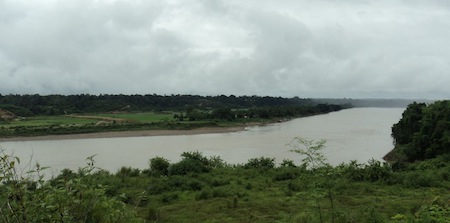The controversial Tamanthi Dam project on the upper Chindwin River in western Sagaing Division of Myanmar is resulting in forced relocation and impoverishment of ethnic Kuki communities and threatening endangered wildlife species.
A collaboration between India’s National Hydroelectric Power Corporation (NHPC) and the Department of Hydropower Implementation (DHPI) of Myanmar, the 80 metre high dam is estimated to cost three billion US dollars, with an electricity generation capacity of 1200 MW and annual production of 6,685 Gwh. Approximately 80 per cent of the electricity generated is meant for India’s northeast region while the rest will go to the Monywa mining operation in Myanmar. Although the official agreement was signed in 2004, construction only recently picked up after bureaucratic delays and the inability of the NHPC to tie up with local partners in order to start the project work.
The Tamanthi dam is part of India’s latest efforts at cozying up to the Myanmar military regime and enhances strategic ties with Myanmar, seen as a gateway to the Association of Southeast Asian Nations (ASEAN). Other collaborations have included the ONGC Videsh Limited (OVL) and the Gas Authority of India Limited (GAIL) getting 30 per cent stakes in exploration and production of gas in Myanmar’s A1 and A3 offshore blocks located at Sittwe in Arakan State. Talks are also on between Myanmar and India to bring the gas through a 1,575 km pipeline, from Sittwe port in Myanmar through Aizwal–Silchar-Guahawti-Siliguri to Gaya (Bihar), and linking it to the Haldia-Jagadishpur oil pipeline in Gaya. India is also keen to ramp up security operations along with Myanmar in its sensitive northeast region where insurgent groups operate from camps located across the border in the Kachin and Sagaing provinces of Myanmar.
The Tamanthi dam’s reservoir will flood almost 1,400 square kilometres including an estimated 52 villages and will permanently displace over 45,000 people, including the entire town of Khamti. Already over 2,400 people have been relocated at gunpoint from the dam site without compensation for loss of property and livelihoods.
Those facing the most impact are the Kuki ethnic people, one of many ethnic groups living along the Chindwin, along with the Kachin, Shan, Naga and Chin. The Kukis have been living on both sides of the border after India and Myanmar got demarcated after independence from the British. Over 600,000 Kuki people live in northeast India in Manipur, Nagaland, Tripura, Assam and Mizoram States, and over 200,000 live in northwest Myanmar, in Upper Sagaing Division and Tungzang township of Chin State.
The dam will also flood parts of the Tamanthi Wildlife Reserve that provides habitats for the tiger and elephant as well as the endemic Myanmar’s Roofed Turtle (Kachuga travittata). One of the world’s most critically endangered freshwater turtles, the Kachuga trivittata is considered an endangered species by the International Union for Conservation of Nature (IUCN). Less than a dozen living examples of the species are known to exist, and wild populations known only to remain in two rivers: the Chindwin River and the Dokhtawady River in Mandalay Division in Myanmar.
Forced relocation by armed forces is common practice in Myanmar’s infrastructure projects. At the Tamanthi dam site, the two villages of Leivomjang and Tazone, of about 600 and 1,800 people respectively, were forcibly moved out during January to March 2007. Villagers were ordered to move forty miles south to a relocation site called Shwe Pye Aye or “new town.” Soldiers from Light Infantry Battalion 222 at Homalin used bulldozers to knock down the buildings and flatten farmlands and gardens around the villages. The army also razed the church and cemetery in Leivomjang. The officials provided a paltry compensation of 5,000 kyat (US$5) to families for the loss of houses and farmlands.
The resettlement site offers few benefits. Villagers suffer scarcity of water and fuelwood while the farmlands located far from their new homes are mostly sandy soil. So not everyone has accepted the relocation despite threats and destruction of their houses. “I will never leave Leivomjang. My family has been living here and cultivating the land since my grandparents’ time. My house, which cost 30 million kyat (about US$30,000), was knocked down. I have built a hut in its place. The soldiers have come and destroyed it three times! But each time I’ve rebuilt it. I lost so much when they destroyed my fields. I got almost nothing as compensation. This Tamanthi dam has made all of us here poor,” said a 70 year-old woman from Leivomjang village.
India’s NHPC, is no stranger to controversial dam plans that flout environmental laws and regulations given its previous work in India’s northeast that is home to over 100 indigenous peoples. In the Dzongu region in India’s Sikkim state, home to the Lepcha ethnic people, large areas have been declared a Biosphere Reserve to protect the region’s extraordinary biodiversity. However, the NHPC has been planning and building a series of dams that threatens both the Lepcha people and the Biosphere Reserve.
Amraapali N. is a writer based in Bangkok ([email protected]).
 Facebook
Facebook  Twitter
Twitter  Soundcloud
Soundcloud  Youtube
Youtube  Rss
Rss 